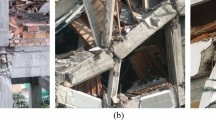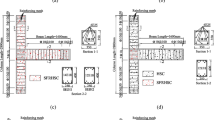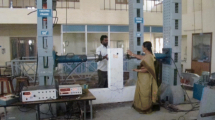Abstract
It was experimentally validated that partially debonded high-strength longitudinal reinforcement can provide strong self-centering capacity to minimize residual deformation, and greatly mitigate seismic damage of column. To continuously investigate the influence of partially debonded longitudinal rebars (PDLR) of column and beam on seismic behaviors of beam-column joint assembly, three interior and three exterior joint specimens were fabricated to subject to cyclic lateral loading. It was showed experimentally that joint specimens with PDLRs in both beams and columns had slighter seismic damages, smaller stiffness and energy dissipating ratios, better ductility compared with joint specimens without PDLRs in the beams. Furthermore, the lateral load of joint specimens without PDLRs in the beams decreased from lateral drift of about 4.0%–5.0% due to much crushing and spalling of concrete in the compressive zones of the beams. Whereas, joint specimens with PDLRs in the beams had continuously increased lateral load until lateral drift up of 10.0%. An analytical approach was derived to evaluate the lateral behavior of beam-column joint assembly which can considering joint deformation and steel bond slip. The proposed approach can reasonably predict the lateral behaviors of joint specimens with or without PDLRs. Analytical results indicate that approximately 70% of total deformation of joint specimens with PDLRs in both beams and columns is contributed by slippage deformation of the beams, whereas, that contribution ratio of the other joint assembly specimens is only 30%.

























Similar content being viewed by others
Abbreviations
- A st :
-
Total area of tensile steel rebar
- A sc :
-
Total area of compressive steel rebar
- A si :
-
Total area of longitudinal reinforcement layer i
- BI :
-
Beam reinforcement index (= ρb × fyb)/fc)
- B 1 , B 2 :
-
Resultant carried by compressive concrete of beam section
- b :
-
Width of cross-section
- b j :
-
Effective width of joint
- b b :
-
Width of beam section
- b c :
-
Width of column section
- C 1, C 2 :
-
Resultant carried by compressive concrete of column section
- d b :
-
Diameter of reinforcing bar
- E s :
-
Young’s modulus of steel
- E si :
-
Young’s modulus of longitudinal reinforcement layer i
- e :
-
Eccentricity
- E n :
-
Dissipated energy at each lateral loading cycle
- f c :
-
Measured concrete compression strength of cylinder according to material test
- f y :
-
Yield stress of steel
- f yb :
-
Yield stress of beam reinforcement
- f yj :
-
Yield stress of joint transverse reinforcement
- f u :
-
Ultimate stress
- f s :
-
Stress of tension longitudinal bar
- f st :
-
Resultant forces of tensile longitudinal rebars in a structural section
- f sc :
-
Resultant forces of compressive longitudinal rebars in a structural section
- H :
-
Lateral force resisted by the lateral actuator
- h :
-
Height of cross-section
- h eq :
-
Energy dissipation damping ratio
- h c :
-
Height of column section
- h b :
-
Height of beam section
- h 0 :
-
Effective height of cross-section
- JI :
-
Joint transverse reinforcement index (= ρj × fyj)/fc)
- JPR :
-
Factor for in-plane geometry, 1.0 for interior, 0.588 for exterior and 0.323 for knee joints
- JPRU :
-
Factor with 5/6 reduction to JPR
- k e :
-
Enhanced ratio of moment capacity of cross-section
- K i :
-
Secant stiffness of beam-column joint assembly at lateral loading cycle i
- L :
-
Shear span length
- L c :
-
Shear span of column
- L b :
-
Shear span of beam
- l pd :
-
Designed length of partially debonded steel rebar
- l p :
-
Length of plastic hinge of column
- M n :
-
Moment capacity of cross-section
- M c :
-
Moment resisted by column section
- M b :
-
Moment resisted by beam section
- m :
-
Eccentricity between the beam centerline and the column centroid exceeds bc/8, m = 0.3, other cases, m = 0.5
- N′ :
-
Axial load computed by using Eq. (2)
- N :
-
Axial load applied to cross-section
- N c :
-
Axial load carried by concrete
- N s :
-
Axial load carried by longitudinal reinforcements
- n :
-
Axial load ratio
- P my :
-
Yield flexural strength capacity of beam
- R :
-
Lateral drift
- R peak :
-
Measured lateral drift at Vpeak
- R ja :
-
Total lateral drift of beam-column joint assembly
- R cf :
-
Lateral drift due to flexural deformations of column
- R bf :
-
Lateral drift due to flexural deformations of beam
- R cs :
-
Lateral drift due to slip deformations of column
- R bs :
-
Lateral drift due to slip deformations of beam
- R f :
-
Lateral drift due to flexural deformation (Rcf or Rbf)
- R s :
-
Lateral drift due to slip deformation (Rcs or Rbs)
- T c1 ,T c2 :
-
Resultant tensile forces of longitudinal rebars of columns
- T b1 ,T b2 :
-
Resultant tensile forces of longitudinal rebars of beams
- u :
-
Bond strength of steel rebar
- V :
-
Shear force
- + V i,max :
-
Positive lateral force at lateral loading cycle i
- − V i,max :
-
Negative lateral force at lateral loading cycle i
- V n :
-
Nominal shear resistant capacity of joint
- V b :
-
Shear force resisted by beam section
- V c :
-
Shear force resisted by column section
- V peak :
-
Average measured peak lateral force
- v j,h :
-
Shear stress of joint in the transverse direction
- v j,v :
-
Shear stress of joint in the longitudinal direction
- v j :
-
Horizontal shear stress calculated according to the Kim and LaFave model
- W e1 :
-
Equivalent area of positive half of loop
- W e2 :
-
Equivalent area of negative half of loop
- X n :
-
Neutral depth of compressive zone of concrete
- X nc :
-
Neutral depth of column section
- y i :
-
Distance of longitudinal reinforcement layer i to the most out end of cross-section
- ε y :
-
Yield strain
- Ψ :
-
Elongation ratio steel
- Δ :
-
Displacement at the loading point of column
- + Δ i,max :
-
Lateral displacement at + Vi,max
- − Δ i,max :
-
Lateral displacement at − Vi,max
- ϕ :
-
Curvature of column section in hinge region
- ε s :
-
Tensile strain of longitudinal rebar at beam-column intersection
- ε si :
-
Strain of longitudinal reinforcement layer i
- ε c :
-
Any concrete strain at the most out fiber
- ε cb :
-
Any concrete strain at the most out fiber of beam section
- ε cc :
-
Any concrete strain at the most out fiber of column section
- ε c0 :
-
Concrete strain at peak stress
- σ(ε c ) :
-
Concrete stress at any strain εc
- γ j :
-
Shear strain of joint
- γ n :
-
Factor accounting for the effect of geometry in-plane
- П :
-
Factor of power function of neutral depth
- Г :
-
Factor of power function of neutral depth
- α γt :
-
= (JPRU)2.1 is the parameter for describing in-plane geometry
- α t :
-
Parameter for describing in-plane geometry: 1.0 for interior connections, 0.7 for exterior connections, and 0.4 for knee connections
- β :
-
Coefficient of equivalent neutral depth of compressive zone of concrete
- β t :
-
Parameter for describing out-of-plane geometry: 1.0 for subassemblies with zero or one transverse beam, and 1.18 for sub-assemblies with two transverse beams
- β γt :
-
Parameter for describing out-of-plane geometry (1.0 for subassemblies with zero or one transverse beam, and 1.4 for subassemblies with two transverse beams)
- η t :
-
= (1 − e/bc)0.67, describes joint eccentricity (1.0 for no eccentricity)
- η γt :
-
= (1 − e/bc)0.6, describes joint eccentricity (1.0 for no eccentricity)
- ρ b :
-
Beam reinforcement ratio
- ρ j :
-
Volumetric joint transverse reinforcement ratio in the direction of loading
- θ :
-
Lateral drift angle of specimen
References
ACI-ASCE 352 (2002) Recommendation for design of beam-column connections in monolithic reinforced concrete structures. American Concrete Institute, Farmington Hills, MI, USA
AIJ (Architectural Institute of Japan) (2010) AIJ standard for structural calculation of reinforced concrete structures. Marauzen, Tokyo (in Japanese)
Ang BG, Priestley MJN, Paulay T (1989) Sesimic shear strength of circular reinforced concrete columns. ACI Struct J 86(1):45–59
Attaalla SA (2003) Deformation characteristics of reinforced concrete beam-column joint cores under earthquake koading. Adv Struct Eng 6(1):15–21
Choi JW, Ali M, Alexander SD (2009) Behavior of slab column connections with partially debonded reinforcement under lateral loading. Can J Civ Eng 36(3):463–472
Clayton PM, Winkley TB, Berman JW, Lowes LN (2012) Experimental investigation of self-centering steel plate shear walls. J Struct Eng 138(7):952–960
Dowden DM, Purba R, Bruneau M (2012) Behavior of self-centering steel plate shear walls and design considerations. J Struct Eng 138(1):11–21
EN 1992-1-1 (2004) Eurocode 2: design of concrete structures: part 1-1: general rules and rules for buildings. European Committee for Standardisation
Federal Emergency Management Agency (2000) Prestandard and commentary for the seismic rehabilitation of building (FEMA 356). Reston, VA
Funato Y, Sun YP, Takeuchi T, Cai GC (2012) Modeling and application of bond characteristic of high-strength reinforcing bar with spiral grooves. Proc Jpn Concr Inst 34(2):157–162 (in Japanese)
GB 50011-2010 (2010) Code for seismic design of buildings. Ministry of Housing and Urban-Rural Construction of the People’s Republic of China
Hassanli R, Elgawady MA, Mills JE (2016) Experimental investigation of in-plane cyclic response of unbonded posttensioned masonry walls. J Struct Eng 142(5), 04015171
Huang Y, Yi WJ, Clay JN, Zhang R (2018) Seismic performance of precast concrete frames with debonded reinforcement. Mater Struct 51:47. https://doi.org/10.1617/s11527-018-1174-3
Ibrahim A, Wu G, Sun ZY, Cui HR (2017) Cyclic behaviour of concrete columns reinforced with partially unbonded hybrid. Eng Struct 131:311–323
Ichikawa S, Matsuzaki H, Moustafa AM, Elgawady MA, and Kawashima K (2016) Seismic-resistant bridge columns with ultrahigh performance concrete segments. J Bridge Eng 21(9), 04016049
Kawashima K (1997) The 1996 Japanese seismic design specifications of highway bridges and the performance-based design. In: Proceedings of international conference at Bled 1997, Slovenia, pp 229–240
Kim DH (2012) Seismic performance evaluation of structure considering inelastic behavior of RC beam column joints. Master thesis, Sungkyunkwan Univeristy, Korea
Kim J, LaFave JM (2007) Key influence parameters for the joint shear behaviour of reinforced concrete (RC) beam-column connections. Eng Struct 29:2523–2539
Kim J, LaFave JM (2008) Probabilistic joint shear strength models for design of RC beam-column connections. ACI Struct J 105:770–780
Kim J, LaFave JM, Song J (2007) A new statistical approach for joint shear strength determination of RC beam-column connections subjected to lateral earthquake loading. Struct Eng Mech 27:439–456
Kim J, LaFave JM, Song J (2009) Joint shear behavior of RC beam-column connections. Mag Concr Res 61:119–132
Kurama YC, Sause R, Pessiki S et al (2002) Seismic response evaluation of unbonded post-tensioned precast walls. ACI Struct J 99(5):641–651
LaFave JM, Kim J (2011) Joint shear behavior prediction for RC beam-column connections. Int J Concr Struct Mater 5(1):57–64
Lee JY, Park J, Kim C (2019) Deformations of reinforced-concrete beam–column joint assemblies. Mag Concr Res. https://doi.org/10.1680/jmacr.18.00368
Lehman DE, and Moehle JP (2000) Seismic performance of well-confined concrete bridge columns. Pacific earthquake engineering research center, University of California, Berkeley, CA, USA, PEER-1998/01
Lodhi MS, Sezen H (2012) Estimation of monotonic behavior of reinforced concrete columns considering shear–flexure–axial load interaction. Earthq Eng Struct Dyn 41(15):2159–2175
Nikoukalam MT, Sideris P (2017) Experimental performance assessment of nearly full-scale reinforcement concrete columns with partially debonded longitudinal reinforcement. J Struct Eng 143(4):04016218. https://doi.org/10.1061/(ASCE)ST.1943-541X.0001708
Ohtani S (1997) Development of performance-based design methodology in Japan. In: Proceedings of international conference at bled, Slovenia, pp 59–68
Pang JB, Eberhard MO, Stanton JF (2010) Large-bar connection for precast bridge bents in seismic regions. J Bridge Eng. https://doi.org/10.1061/(ASCE)BE.1943-5592.0000081
Park R (1989) Evaluation of ductility of structures and structural assemblages from laboratory testing. Bull Newland Natl Soc Earthq Eng 22(3):155–166
Parra-Montesinos GJ (2000) Seismic behavior, strength, and retrofit or exterior RC column-to-steel beam connections. Ph.D. Thesis, Department of Civil Engineering, University of Michigan, Ann Arbor, MICH
Parra-Montesinos GJ (2005) High-performance fiber-reinforced cement composites: an alternative for seismic design of structures. ACI Struct J 102(5):668–675
Parra-Montesinos GJ, Wight JK (2002) Prediction of strength and shear distortion in R/C beam-column joints. S.M. Uzumeri Symposium: behavior and design of concrete structures for seismic performance (SP197), American Concrete Institute, Detroit, MI, pp 191–214
Parra-Montesinos GJ, Peterfreund SW, Chao SH (2005) Highly damage-tolerant beam-column joints through use of high-performance fiber-reinforced cement composites. ACI Struct J 102(3):487–495
Paulay T, Park R, Priestley MJN (1978) Reinforced concrete beam-column joints under seismic actions. ACI J 75:585–593
Popovics S (1973) A numerical approach to the complete stress–strain curves for concrete. Cem Concr Res 3(5):583–599
Priestley MJN, Tao JR (1993) Seismic reponse of precast prestressed concrete frames with partially debonded tendons. PCI J 38(1):58–69
Rahman MA, Sritharan S (2007) Performance-based seismic evaluation of two five-story precast concrete hybrid frame buildings. ASCE J Struct Eng 133(11):1489–1500
Setzler EJ, Sezen H (2008) Model for the lateral behavior of reinforced concrete columns including shear deformations. Earthq Spectra 24(2):493–511
Sezen H (2000) Seismic behavior and modeling of reinforced concrete building columns. PhD dissertation, University of Washington, Washington, DC, USA
Sezen H, Chowdhury T (2009) Hysteretic model for reinforced concrete columns including the effect of shear and axial load failure. J Struct Eng 135(2):139–146
Sezen H, Setzler EJ (2008) Reinforcement slip in reinforced concrete columns. ACI Struct J 105(3):280–289
Sun YP, Sakino K (1996) Flexural behaviour of high strength RC columns confined by rectilinear reinforcement. J Struct Constr Eng 486:95–106
Sun YP, Koyama T, Takashi T (2013) Seismic performance and evaluation of fly-ash concrete column. In: Proceedings of the third international conference on sustainable construction materials and technologies, 13
Sun YP, Cai GC, Takeuchi T (2013b) Seismic behavior and performance-based design of resilient concrete columns. Int J Appl Mech Mater 438–439:1453–1460
Tanaka M, Esaki F, Ono M et al (2004) Hysteresis response of R/C column with high strength unbonded longitudinal reinforcing bars. Proc Jpn Concr Inst 26(2):181–186 (in Japanese)
Teraoka M, Fujii S (2000) Seismic damage and performance evaluation or R/C beam-column joints. The Second US-Japan workshop on performance-based engineering for reinforced concrete building structures, hokkaido, Japan, pp 379–390
Teraoka M, Kanoh Y (1994) Structural behavior of interior beam-column joints with normal-to-high strength concrete. 2nd U.S.-Japan-NZ-Canada Multilatera lMeeting on Structural Performance of HSC in Seismic Region, Honolulu, Hawaii, 7-2B
Vecchio FJ (1992) Finite element modeling of concrete expansion and confinement. J Struct Eng ASCE 118(9):2390–2405
Vecchio FJ, Collins MP (1986) The modified compression-field theory for reinforced concrete elements subjected to shear. ACI Struct J 83(2):219–231
Wang JH, Sun YP (2019) Equivalent stress block to characterise force–displacement behaviour of circular RC column considering steel bond slip. Mag Concr Res. https://doi.org/10.1680/jmacr.19.00104
Wang JH, Sun YP (2020) Influence of bond property of longitudinal bars on seismic behaviors of RC columns. Mag Concr Res 72(15):778–798. https://doi.org/10.1680/jmacr.18.00563
Wang JH, Zhao H (2018) High performance damage-resistant seismic resistant structural systems for sustainable and resilient city: a review. Shock Vib. https://doi.org/10.1155/2018-/8703697
Wang JH, Zhao H, He J (2019) Seismic behaviors and resilient capacity of CFRP-confined concrete columns with partially debonded high-strength steel rebars. Compos Struct 222:110912. https://doi.org/10.1016/j.compstruct.2019.110912
Watson S, Park R (1989) Design of reinforced concrete frames of limited ductility. Report 89-4, Department of Civil Engineering, Univeristy of Canterbury, Christchurch, New Zealand, p 232
Xiao Y (2019) Experimental methods for seismic simulation of structural columns: state-of-the-art review and introduction of new multiuse structural testing system. J Struct Eng 145(3):040118269. https://doi.org/10.1061/(ASCE)ST.1943-541X.0002269
Xiao Y, Martirossyan A (1998) Seismic performance of high-strength concrete columns. J Struct Eng 124(3):241–251
Yu J, Tan KH (2013) Special detailing techniques to improve structural resistance against progressive collapse. J Struct Eng. https://doi.org/10.1061/(ASCE)ST.1943-541X.0000886
Zhang PZ, Hou S, Ou JP (2016) A beam–column joint element for analysis of reinforced concrete frame structures. Eng Struct 118:125–136
Acknowledgements
The research reported herein was supported by the National Natural Science Foundation of China (Project No: 51708288).
Author information
Authors and Affiliations
Corresponding author
Ethics declarations
Conflict of interest
The authors declare that there is no conflict of interest regarding the publication of this paper.
Ethical approval
Authors state that the research was conducted according to ethical standards.
Additional information
Publisher's Note
Springer Nature remains neutral with regard to jurisdictional claims in published maps and institutional affiliations.
Appendix
Appendix
AIJ standard-prescribed equations to evaluate the yield flexural strength (Pmy) of general concrete beams are written as follows (AIJ 2010):
ACI-ASCE code was used to calculate the nominal shear strength of beam-column joint (ACI-ASCE 2002):
Rights and permissions
About this article
Cite this article
Wang, J.H. Cyclic behaviors of reinforced concrete beam-column joints with debonded reinforcements and beam failure: experiment and analysis. Bull Earthquake Eng 19, 101–133 (2021). https://doi.org/10.1007/s10518-020-00974-1
Received:
Accepted:
Published:
Issue Date:
DOI: https://doi.org/10.1007/s10518-020-00974-1




